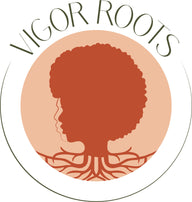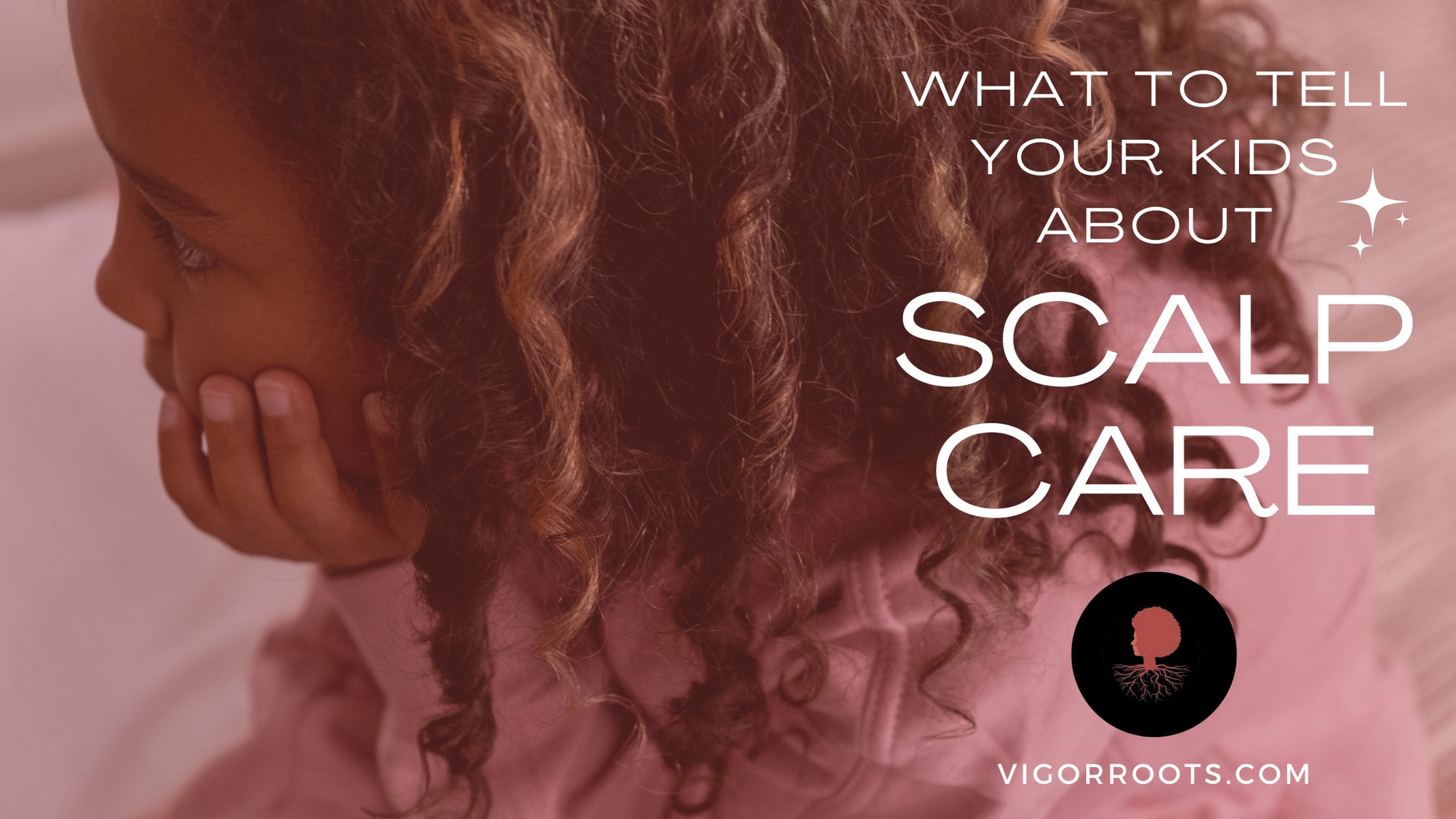
Teaching kids how to have a healthy scalp care routine sets them up to sustain healthy scalps and healthy hair throughout their lifetimes.
When we teach our kids how to have a healthy scalp care routine, we are also reversing generational cycles of preventable hair loss.
Here are some ways to help your kids understand scalp care and form positive associations with the process.
Make It Fun
Kids are more likely to carry a healthy scalp care routine into their adulthood if they form positive associations with scalp care in childhood.
“Making the scalp care routine a bonding experience rather than a chore will make them love it. They’ll think of it as time they get to spend with mom or dad.” -Nathalee DuRose, Vigor Roots Founder
To make it extra fun, you can try playing music or letting them watch TV while you brush and style their hair.
DuRose recommends finding age-appropriate books about your child’s hair type and hair care and reading with them. This can help children to normalize healthy hair care and know what to expect when they go to see a stylist, etc.
Use Gentle Hair Products
The following products are essential for healthy scalp care routines for children:
- Detangler
- Shampoo
- Conditioner
- Scalp serum
Parents should be very careful to only purchase gentle products that do not contain harsh chemicals.
It’s harder to create positive associations with scalp care when the products you use are painful or irritate the child’s scalp.
Look for mild, natural, non-allergenic ingredients. Be careful with scents, especially if your child has sensitive skin.
Get The Right Tools For Your Child’s Hair
It’s also important to select the proper brushes, combs, and styling tools for your child’s hair.
Different ages and hair types require different styling tools, and using the wrong one could lead to inadvertently damaging or pulling out hair.
“If you make this process hard for kids, they’ll hate it. Not just now, but as adults. I know lots of adults who hated having their hair combed as kids who don’t brush their hair now,” DuRose explains.
If you’re not sure about the proper tools and products for your child’s age and hair type, schedule an appointment with a stylist and get their recommendations.
Set a Regular Hair Washing Schedule
Regular cleansing is an essential part of every healthy scalp care routine. Make sure to regularly wash and condition your child’s hair.
The frequency of how often you should wash your child’s hair depends on their age and hair type. DuRose recommends weekly hair washes for very curly, coiled textures, every other day for wavy textures, and daily for fine, straight hair.
More frequent washes may be necessary if your child is particularly active and sweating a lot or uses a lot of hair products that cause buildup on the scalp.
Again, if you’re not sure how often to wash your child’s hair, ask your stylist.
Keep an Eye Out For Scalp Conditions
It’s important to regularly assess your child’s scalp for anything out of the ordinary. Since children don’t come into the world experts on scalp health, they might not realize that they should tell you when something is off.
Children are prone to many scalp conditions including:
- Cradle cap
- Lice
- Eczema
- Allergic reactions to products
An itchy scalp is the most common indication of a problem, so let your kids know they should always tell you if their head feels really itchy.
You should also regularly examine their scalps for:
- Lice
- Bumps
- Dandruff
- Redness
- Blistering
Regularly washing your child’s hair not only protects against many scalp infections, it also helps you to understand what your child’s healthy scalp looks like so that you can quickly identify any changes that might indicate a problem.
If you do notice a problem, get in touch with your stylist or pediatrician right away so they can let you know the proper treatment.
Beware of counting solely on Google. The internet has a multitude of information… and misinformation. That’s why it’s best to consult a professional when it comes to matters of your child’s scalp health.
Take Your Child To a Stylist
Speaking of professionals, even if your child isn’t experiencing a scalp condition, get them into the good hair habit of regularly seeing a professional stylist.
What age should they start seeing a stylist? When it looks like they need a haircut! It varies depending on the child’s unique hair situation. But by the time they’re age 5, DuRose recommends taking them in to get their split ends trimmed regularly.
Teens and adults should see a stylist at least every 3 months to maintain healthy hair, so it’s good to normalize seeing a stylist for kids so that they can get into the habit early on.
Break Generational Cycles of Preventable Hair Loss
Scalp care can actually have a huge cultural impact.
“It’s personal for me. I wish I knew not to add chemicals to my hair when I was a teenager and my scalp was in that tender stage of developing healthy hair follicles. I was so excited to have my hair nice and straight, but my hair never was healthy again until I went to my natural hair.
My aunt used to have long flowing hair down her back. She got 1 at-home color and since then her head has been bald. (Now her hair is coming back with Root22Serum.)
I don’t want to see my kids or my relatives’ kids say, “We should go get colors, weaves, wigs” and then, 30 years later, their scalp is just really damaged, their hair is thinning, the quality of their hair is deteriorating from how much they’ve damaged it.” -Nathalee DuRose, Vigor Roots Founder
Many adults today suffer from hair thinning and loss that could have been entirely prevented had they implemented proper scalp care early in their lives. Many adults today could slow or even stop hair thinning now if they embrace a healthy scalp care routine.
But, because many of these adults’ parents, and their parents before them had hair thinning and loss, many assume that the balding is hereditary. Yes, some hair loss can be hereditary, but sometimes it’s simply due to poor scalp care.
So, what’s behind these preventable cycles of generational hair loss? Well, part of it is that down through the family line, several generations never learned proper scalp care.

Another part is that many of us learned that “good hair” had a very narrow definition and that if Black and other communities of color wanted this “good hair” we’d have to undergo drastic, extreme processes that often involved excessive heat, harsh chemicals, and styles that placed extra tension on the scalp.
We watched our parents and communities embrace these extreme styles and assumed that this was “normal” hair care, never realizing that these routines were causing sometimes irreparable damage to our natural hair.
So, when we teach our kids how to properly care for their scalps, not only are we teaching them lifelong healthy hair habits and breaking generational cycles of preventable hair loss, we’re also healing our collective relationship to our natural hair.
“I hope this education goes beyond my kids to their kids and their kids' kids,” DuRose says.
Teach Your Kids To Love Their Texture
As you teach your kids to properly care for their scalps, you can also teach them to love their hair in all its natural glory.
“Loving your texture is so important, especially in Black communities,” DuRose said. “We’re not trained to embrace our own textures enough.”
If children learn early on to celebrate their natural hair, they are less likely to try drastic styles that could damage their natural hair later in life. (Or at least they’ll know to go to a stylist and take extra precautions to nurture their scalps so that they don’t ruin their ability to regrow their natural hair when they choose to.)
“I wish I’d been educated to embrace my natural texture,” DuRose continued. “It would have prevented a lot of hair damage and breakage in my 20s and 30s. It would have prevented me from having to wear wigs and weaves and braids to cover the breakages from my 20s and 30s.”
Teaching your kids how to have a healthy scalp care routine is a powerful act of generational healing that sets your children up for a lifetime of full, happy, luscious hair.
Don’t forget to follow us on Instagram for more scalp care tips. And, if you’re ready to give your scalp some extra love, get your bottle of our all natural, luxurious scalp treatment: Root22Serum.


